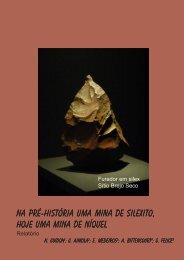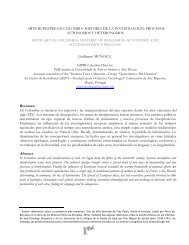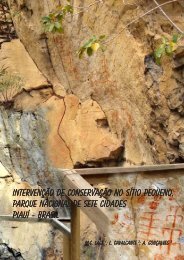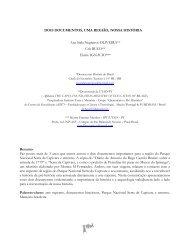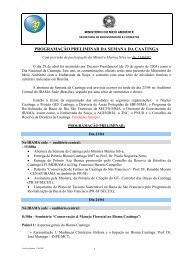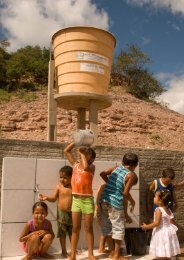Untitled - Fundação Museu do Homem Americano
Untitled - Fundação Museu do Homem Americano
Untitled - Fundação Museu do Homem Americano
Create successful ePaper yourself
Turn your PDF publications into a flip-book with our unique Google optimized e-Paper software.
Global Rock Art Congress<br />
29 Junho – 3 de Julho 2009<br />
Depiction of an Ancient Ritual in the Southwest?<br />
Peggy Whitehead, Esta<strong>do</strong>s Uni<strong>do</strong>s<br />
In the Southwest area of the United States is a wealth of pre historic rock Art. The marginal subsistence<br />
of the arid land has forced cultural groups to migrate into and out of the area. Traces of these people<br />
and their ceremonies are hinted at in the panels etched and painted onto the high cliffs. One such painted<br />
panel outside of Moab, Utah depicts such a ceremony. The elaborate clothing on the central fi gure<br />
hints of importance, while the flanking figures are clothed in regalia and the group to the side are merely<br />
sha<strong>do</strong>ws. The clothing as well as the juxtapositioning of the figures will be examined.<br />
(Artigo 64 IFRAO2009)<br />
Masto<strong>do</strong>ns, Masks and Misunderstandings<br />
Reinal<strong>do</strong> Morales Jr., Esta<strong>do</strong>s Uni<strong>do</strong>s da América<br />
This paper will address the interpretation of several examples of Brazilian rock art. In the last few decades<br />
of rock art research in Brazil we have seen a variety of interpretive stances, from pragmatically conservative<br />
to highly imaginative. The differences seem to arise from metho<strong>do</strong>logies that variously privilege form,<br />
iconography or a presumed iconology in their efforts to interpret the imagery. This paper will address three<br />
areas of interpretation: zoomorphic imagery (megafauna or not?), anthropomorphic imagery (people or<br />
personages?), and hunting/warfare imagery (<strong>do</strong>cumentary or display?).<br />
Arte rupestre del estilo pisadas asocia<strong>do</strong> a industria lítica sobre lascas tipo lesmas/limaces en<br />
Amambay (Paraguay).<br />
Jose A. Lasheras, Pilar Fatás, Maricer González, Ramón Montes & Emilio Muñoz<br />
En el marco de un proyecto de cooperación cultural y científica con la asociación del pueblo Paî Tavyterâ,<br />
Paî Retâ Joaju (PRJ), con la Sociedad de Apoyo Indígena (SAI) y subvenciona<strong>do</strong> por la Agencia Española<br />
de Cooperación (AECID) en abril de 2008 realizamos el estudio arqueológico del abrigo Itaguy Guasu en<br />
el cerro Jasuka Venda (dpto de Amambay, Paraguay) y prospecciones en otros abrigos de la región.<br />
Se trata de un abrigo de 50 metros de frente, en cuya pared inventariamos 1.353 motivos graba<strong>do</strong>s de<br />
lo que se denomina estilo pisadas por el pareci<strong>do</strong> de ciertos temas con la huella de ñandú, de vena<strong>do</strong><br />
o guanaco y de jaguar o puma (según la región en que se halle) y con la pisada humana. La pequeña<br />
excavación realizada ha depara<strong>do</strong> un nivel espeso de ocupación, con industria lítica sobre cuarcita y<br />
lascas planoconvexas, de tipo lesma/limace. Un hogar halla<strong>do</strong> ha si<strong>do</strong> data<strong>do</strong> por TL en 5.200 BP, quizá la<br />
datación conocida mas antigua asociada a este estilo de arte rupestre presente en Brasil y Argentina.<br />
71<br />
Wild Goat (Ibex), Hunting and Rock Art Interpretation in Iran<br />
Sirvan Mohammadi, Irã<br />
Like other countries, interpretation is also one of the main metho<strong>do</strong>logical limitations of rock art studies<br />
in Iran. The depiction of wild goat (ibex) is one of the most common icons which can be seen in nearly<br />
all rock art sites in Iran. Such pictures usually have been shown in a hunting scene and there is not a<br />
clear interpretation until now about them. Sometimes it has been proposed that large number of known<br />
rock art sites in Iran have been created by hunter groups without any clear means and was created just<br />
for amusement and pleasure. But, as discussed this conclusion cannot be true for all of Iranian rock art<br />
and strong associations between environments in which rock art sites are occurring and natural habitat<br />
of this animal (wild goat or ibex) can play a key role in understanding the meaning of Iranian rock art.<br />
(Artigo 65 IFRAO2009)<br />
Parque Nacional Serra da Capivara<br />
Piauí, Brasil




